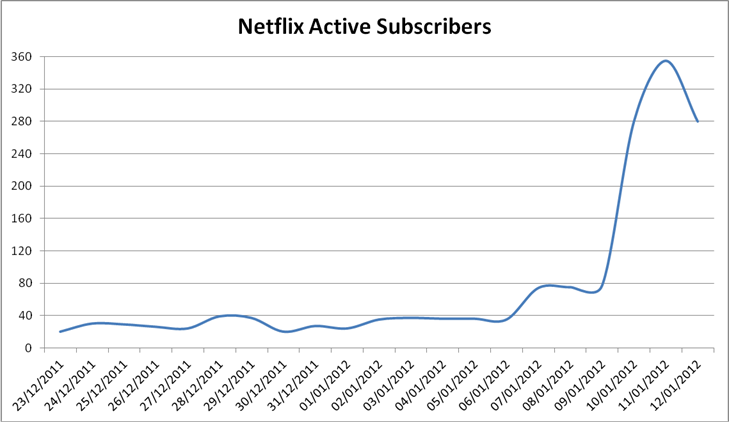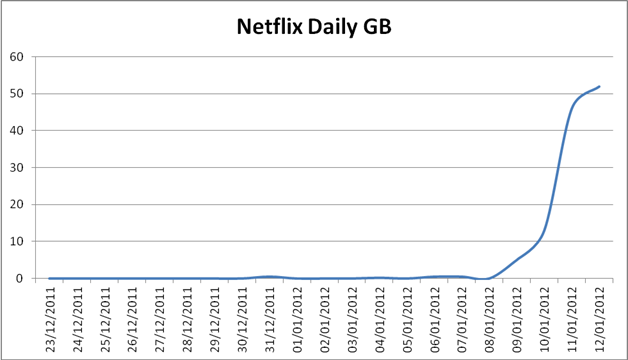Netflix launches in the UK … time to get Fibre?
- Subscribe to RSS Feed
- Mark as New
- Mark as Read
- Bookmark
- Subscribe
- Printer Friendly Page
- Report to Moderator
- Plusnet Community
- :
- Plusnet Blogs
- :
- Netflix launches in the UK … time to get Fibre?
Netflix launches in the UK … time to get Fibre?
 Netflix has just launched in the UK, meaning you can stream unlimited movies and TV episodes straight from t'internet to your PC, laptop, games console or TV - from just £5.99 a month. But, before you sign up and buy in some popcorn, it's probably worth making sure you've got the right broadband for the job. That way you'll know you can kick back and watch your favourite flicks straight away, instead of waiting ages for movies to load while your bandwidth struggles. Just read on to find out which broadband's best for streaming movies and TV episodes, and why fibre optic broadband could be just the thing for you.
Netflix has just launched in the UK, meaning you can stream unlimited movies and TV episodes straight from t'internet to your PC, laptop, games console or TV - from just £5.99 a month. But, before you sign up and buy in some popcorn, it's probably worth making sure you've got the right broadband for the job. That way you'll know you can kick back and watch your favourite flicks straight away, instead of waiting ages for movies to load while your bandwidth struggles. Just read on to find out which broadband's best for streaming movies and TV episodes, and why fibre optic broadband could be just the thing for you.
Lights, camera, stream … Netflix and other hot new streaming services
Film fans have been waiting for Netflix to cross the pond for ages, and - last week - the content streaming giant set up shop in the UK, meaning film fans can now sign up and get unlimited movie and TV programmes streamed straight to their PS3, Xbox, Wii, PC or laptop. And, if you've signed up, you could connect your laptop to your TV to stream your movies if you fancy watching on a bigger screen.
But it's not just Netflix that's making moves in the movie and content streaming sphere - LOVEFiLM has recently introduced its own cheap monthly film streaming package too (LOVEFiLM Instant). Xbox users can already watch the 4OD, Demand 5 and YouTube streaming services, and are also set to be able to access iPlayer soon.
With these hot services on offer, it looks like more of us will be spending less time shopping for DVDs, and more and more time online. But, before streaming content, it's useful to look into the broadband speeds and data allowances you're going to need - so you don't get hit with slow downloads and extra data charges.
Broadband, data and online streaming must knows
What's on screen might have your full attention while you're streaming, but the broadband and data allowances you've got in place can affect what you see on screen, how long it takes to load or buffer, and how much you can actually watch without going over your data allowance.
We've put together some guides to what you'll need broadband and data wise for Netflix and LOVEFiLM (in case you're already signed up with these guys) below, so you can find out what's what before you sit down to watch your flicks.
- Broadband, data and Netflix … According to Netflix, you'll need a minimum broadband speed of 0.5Mb. This is significantly lower than the speed of the average broadband connection, but there are other things you need to consider too. As Netflix admits, speed and data volumes really do matter when it comes to streaming -faster broadband means better quality and bigger data allowances mean more viewing. With Netflix, you can pick from three video quality settings - good (0.3 GB/hour), better (0.7 GB/hour) and best (1 GB/hour). Though, if you're streaming HD content, your data usage could jump up to as much as 2.3 GB/hour. If you stop / start viewing content frequently, your data use could also go a little higher as Netflix streams some data as a buffer each time you start viewing.The default settings for viewing preferences on Netflix are 'good', but you can easily change this setting by logging into your account online.Network analysis outfit Sandvine has shown that the average US Netflix user streams around 30 shows per month - and as each show is, on average, 42 minutes long, most users are racking up some 21 hours of streaming per month. This level of usage is likely to consume between 6.3GB (on 'good' quality) and 48.3 GB (on 'best' quality) of your bandwidth every single month.
- Broadband, data and Lovefilm … As mentioned, LOVEFiLM has recently launched a ‘streaming only’ service of its own (presumably in response to Netflix's appearance on the scene?). LOVEFiLM recommends that you stream movies using a broadband connection that is capable of 2Mbs or more, and allows 500MB of data for every 90 minute movie you stream.It’s worth noting that, despite the more demanding minimum requirements, LOVEFiLM doesn’t actually offer any content in HD format yet (whereas Netflix does).
So, if you're streaming or downloading content through Netflix or LOVEFiLM, you're probably best to opt for fast broadband speeds and a generous monthly data allowance. Or, at least, to work out how many films you can view a month without going over your limit, and only watch that number, so you're not charged extra for excess data. Remember that, with Plusnet, your overnight usage (between midnight and 8am) does not count towards your monthly usage allowance, so all you night owls out there can stream movies during the early hours to your hearts content.
Are people using it?
It certainly seems like it. The limited monitoring we have in place at the moment suggests that Netflix traffic already accounts for more than 60Mbps of our overall bandwidth during peak times. The actual number of people using the service was highest on launch day, however despite the slight reduction in the number of users, total traffic from Netflix is increasing day on day, so a lot of people clearly like what they're seeing.
The the graphs below only represent a small proportion of our network - but they should speak for themselves:
Is fibre optic broadband best for streaming?
You might have heard a lot about fibre - especially if you've been looking into how to stream and download content faster. So we've put a guide together, below, explaining what fibre is and how it relates to streaming, so you can see if it's right for you and whether it's worth you upgrading.
- What is fibre optic broadband? Standard broadband works by sending electrical signals over copper telephone wires all the way to the telephone exchange. The longer the wires, the slower your connection speed. Fibre optic broadband runs much faster by sending signals at the speed of light through glass cabling that connects your local telephone exchange to the green cabinets you'll have seen near or on your street. Copper telephone wires then connect your home to the cabinet. Because the length of copper used is shorter, much faster speeds can be achieved.
- How fast is fibre? Will it help to improve your movie streaming experience? At 40Mbps, fibre's fast. Really fast. In fact, with fibre optic broadband you could download a …- 30 minute TV show in SD in about 1 minute - 30 minute TV show in HD in around 4 minutes - DVD ISO in roughly 15 minutes That's almost 10x faster than a standard 4Mb broadband connection allowing you to stream HD content from all of the popular content providers. You might struggle to do this with a 4Mbps connection, as some HD streaming providers require around 3.5Mbps of bandwidth leaving little room for overhead. And fibre's not just great for movie streaming. It's lightning-fast when it comes to MP3 downloads and gaming too. It'd take you around 16 seconds to download an MP3 using 4Mb broadband - with fibre, it would only take around 2 seconds.
- Is fibre better than broadband when it comes to movie streaming? Not everywhere has access to fibre optic broadband, so most movie streaming services are put together especially with standard broadband in mind. As long as your broadband speed is around 2Mb you should be able to stream most standard-definition content just as well as you’d be able to using Fibre. In order to stream a lot of HD content though, you’re likely to need at least 4Mbps of available bandwidth. Where fibre really comes into its own, is when more than one person wants to use the same home broadband connection at the same time. If you're trying to stream a movie using standard broadband, you might have to ask other people you live with to stop emailing, downloading music, browsing the web or updating Facebook, so you can get the most out of your connection and watch your movie without any buffering, slow-downs or interruptions. But with fibre, multiple people can watch HD streams, game, browse the web, and download music and films all at the same time, without any slow-downs.Fibre packages usually come with higher data allowances too, meaning you can watch more content without going over your data limit and getting hit by extra charges. Our fibre optic broadband and phone packages run from £16.49 a month, and - depending on the broadband package you pick - come with 40GB to 120GB of data to use every month (as well as unlimited data between midnight and 8am). But you can add extra data to our standard broadband packages too. So if you're happy with your speed or can't get fibre in your area, you can always upgrade your data allowance instead of upgrading to fibre.
- Upgrading to fibre or upping your data allowance: If you're already a Plusnet customer, and you can get fibre in your area, you'll be able to upgrade to a fibre optic connection by using our Product Change Tool. You can use this handy broadband availability tool to see whether or not fibre's available in your area yet. If it is, just go to the Plusnet Member Centre, log into your Plusnet account and click on 'Product Change' to get started. You can use this tool to upgrade to a package with a higher data allowance too.
Have you signed up to Netflix or another movie streaming service? Which do you think is better, Netflix or LOVEFiLM? Do you prefer to use fibre optic broadband if you're streaming content or are you happy using standard broadband? Please leave us a comment and let us know.
- Tags:
- netflix


